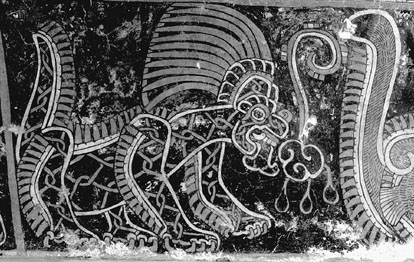

 | Page 1266 |  |
the culprits were, they seemed to have shared Teotihuacán’s belief system, for this was not wanton destruction by invading barbarians.

A restored painting found in Teotihuacán
(Gamma)
Although Teotihuacán’s political power was gone after 750, the city had a sizable population for centuries. For instance, the city still had 40,000 inhabitants in 950. In Aztec times, although the population of Teotihuacán was much reduced, the city was a place of pilgrimage. It was revered by the Aztecs and their contemporaries as the home of the gods, and according to Aztec legend, the current world age was created by the self-sacrifice that the gods made at Teotihuacán. Ironically, that self-sacrifice was done by fire: the gods leaped into a sacred fire to create the sun and other elements of the cosmos.
Despite the tremendous amount that is now known about the great city of Teotihuacán, there is still a great amount that is not known. Even the language that the ancient people of Teotihuacán spoke is not known for certain. Although more is now known about the organization of the city, details of the sociopolitical organization of the city and of the nature of Teotihuacán rulership remain elusive. It is clear, however, that Teotihuacán was the largest and most powerful city in Mesoamerica until the rise of the Aztec capital tenochtitlán in the fourteenth and fifteenth centuries a.d.
References
Berlo, Janet C., ed. 1992. Art, Ideology, and the City of Teotihuacán: A Symposium at Dumbarton Oaks 8th and 9th October 1988. Washington, DC: Dumbarton Oaks Research Library and Collection.
One of the great archaeological discoveries of the twentieth century was made by accident in the spring of 1974. Peasants from the village of Xiyang in Lintong, Shaanxi Province, in the People’s Republic of china, were engaged in digging a well and discovered pottery figures and tiles. The similarity between the tiles discovered in the village well and those unearthed by farmers in the vicinity of the tomb of Qin Shi Huang (China’s first emperor) was noted. Excavation of the site by a team from the Shaanxi Provincial Relics Bureau began in July 1974, and within two years, it
 |  |